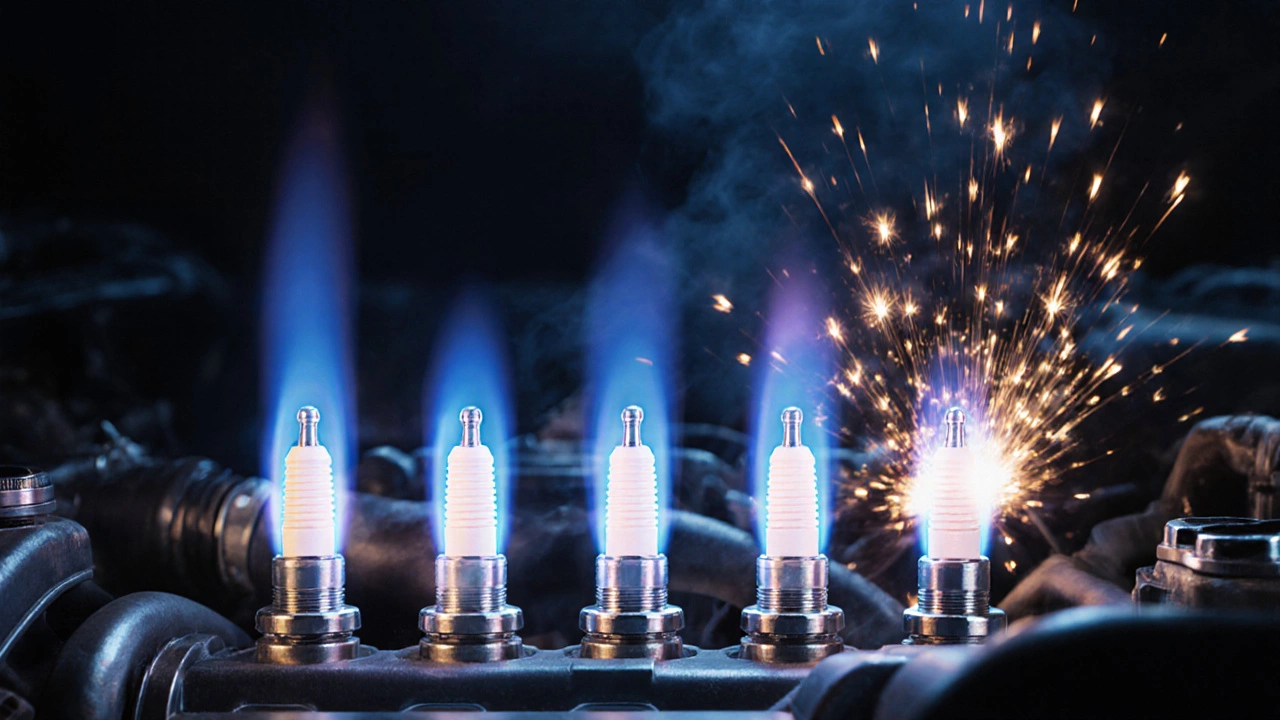Spark Plug Fuel Savings Calculator
Estimate Your Fuel Savings
Worn spark plugs can reduce fuel efficiency by up to 12%. See how much you could save by replacing your spark plugs.
Ever noticed your car feeling sluggish after a few years, then suddenly picking up after a spark plug change? It’s not magic. It’s physics. Spark plugs are tiny, but they control the heartbeat of your engine. When they wear out, your car doesn’t just run worse-it wastes fuel, coughs, hesitates, and sometimes won’t start at all.
What Spark Plugs Actually Do
Every time you press the gas, your engine burns fuel. That burn happens because a spark plug fires a tiny electric arc between two electrodes, igniting the air-fuel mixture in the cylinder. It’s a precise, high-voltage job-thousands of times per minute. Modern spark plugs are made to last 60,000 to 100,000 miles, but that’s under ideal conditions. In real life, carbon buildup, oil leaks, and extreme heat eat away at them.
When a spark plug starts to fail, the arc becomes weak or inconsistent. That means some fuel doesn’t burn completely. You get misfires. You hear a rough idle. You feel the car shudder when you pull away from a stop. Over time, unburned fuel can damage your catalytic converter, which costs hundreds to replace.
What Happens After You Replace Them
After a proper spark plug change, most drivers notice improvements within the first 10 miles. Here’s what typically gets better:
- Engine response: The throttle feels sharper. You don’t have to press as hard to get acceleration.
- Idle smoothness: No more shaking at traffic lights. The engine hums quietly.
- Fuel economy: A study by the Society of Automotive Engineers found that worn spark plugs can reduce fuel efficiency by up to 12%. Replacing them often brings mileage back to factory specs-sometimes even better.
- Start-up reliability: Cold mornings become easier. No more crank-crank-crank.
- Emissions: Cleaner burn means fewer hydrocarbons escaping out the tailpipe. Your car is more likely to pass emissions tests.
One mechanic in Manchester told me about a 2018 Honda Civic that was getting 28 mpg with fouled plugs. After a change, it jumped to 34 mpg. That’s nearly £150 saved per year on fuel-just from swapping four little parts.
When You Won’t Notice a Difference
Not every car will feel like a new ride after a plug change. If your spark plugs were already in good shape, you might not feel much. That’s normal. Spark plugs don’t magically boost power beyond factory design-they restore what was lost.
Also, if your car has other problems-like a dirty air filter, failing fuel injector, or bad oxygen sensor-replacing spark plugs alone won’t fix it. You might think the change didn’t work, but you just didn’t address the real issue.
Here’s a quick rule: if your car is over 60,000 miles and hasn’t had new plugs in the last 3 years, you’re overdue. Even if it seems fine, the damage is already happening under the hood.

Types of Spark Plugs and What They Mean
Not all spark plugs are the same. The three main types are:
- Standard copper: Cheapest. Lasts 20,000-30,000 miles. Good for older cars with simple ignition systems.
- Platinum: Lasts 60,000-100,000 miles. Better heat resistance. Common in cars from the 2000s onward.
- Iridium: Most durable. Lasts up to 120,000 miles. Thinner electrode = stronger spark. Best for modern turbocharged engines.
Always use the type your manufacturer recommends. Putting iridium plugs in an old car designed for copper won’t make it faster-it might even cause misfires. Your owner’s manual tells you exactly what to use. If you don’t have it, check online with your VIN or model year.
How to Tell If You Need New Plugs
You don’t need a mechanic to tell you. Here’s what to look for:
- Check engine light flashing (especially if it’s tied to a misfire code like P0301-P0304)
- Sluggish acceleration, especially when climbing hills
- Engine rattling or knocking under load
- Increased fuel consumption-fill up more often than usual
- Hard starting, especially in cold weather
Some people wait until the car won’t start. Don’t do that. By then, you’ve already burned extra fuel, stressed the starter, and risked damaging the catalytic converter.
DIY or Professional?
Changing spark plugs is one of the few engine tasks a beginner can do safely. You’ll need:
- New spark plugs (correct type and gap)
- Spark plug socket (usually 5/8" or 13mm)
- Extension bar and ratchet
- Gap tool (if not pre-gapped)
- Compressed air or a brush (to clean around the plug wells)
Step-by-step:
- Turn off the engine and let it cool.
- Remove the ignition coil or boot from each spark plug.
- Use the socket to unscrew the old plug. Don’t force it.
- Check the old plug’s tip-black soot means rich fuel mix; white or melted means overheating.
- Gap the new plug if needed (use the tool that comes with it).
- Screw the new plug in by hand first, then tighten with the ratchet. Don’t overtighten.
- Reattach the coil or boot firmly.
Most cars have 4, 6, or 8 plugs. Take one out at a time so you don’t mix up the wires. If your engine has coil-on-plug design (most modern cars), you’ll need to remove the coil first. That’s fine-just label them as you go.
If you’re not comfortable, take it to a garage. Labor costs are usually £40-£80 in the UK, depending on engine access. It’s cheaper than a new catalytic converter.

Myth Busting
Some people swear that premium spark plugs give you more horsepower. They don’t. Not unless your engine was running poorly before. The best spark plug is the one your car was designed for.
Others think you can clean and reuse old plugs. Don’t. Even if you scrub off the carbon, the electrodes are worn. The gap is too wide or uneven. You’re gambling with engine performance.
And no, spark plugs don’t need to be changed every oil change. That’s an old myth. Follow your manufacturer’s schedule. For most cars, that’s every 60,000 to 100,000 miles.
What If It Still Runs Bad After the Change?
If you changed the plugs and nothing improved, here’s what to check next:
- Were the plugs installed correctly? Loose or cross-threaded plugs cause misfires.
- Did you use the right type? Wrong heat range or electrode design = bad performance.
- Is the ignition coil failing? One bad coil can mimic a bad plug.
- Is the fuel system dirty? A clogged fuel filter or injector can cause the same symptoms.
- Is there a vacuum leak? A cracked hose or broken gasket lets in extra air, throwing off the air-fuel mix.
Get a code reader. Even a cheap OBD2 scanner from Amazon can tell you if you’ve got a misfire on cylinder 3 or a faulty oxygen sensor. That’s faster than guessing.
Final Verdict
Yes, your car runs better after a spark plug change-if the old ones were worn out. It’s not a performance upgrade. It’s a restoration. Like changing the oil or replacing brake pads, it’s preventative maintenance that keeps your engine healthy, efficient, and reliable.
Don’t wait for the check engine light. Don’t wait for the car to sputter on the motorway. If you’re past 60,000 miles and haven’t changed them, do it now. You’ll save money, reduce emissions, and drive smoother.
It’s one of the cheapest, easiest fixes with the biggest payoff in your entire car’s life.
How often should I change my spark plugs?
Most modern cars need new spark plugs every 60,000 to 100,000 miles. Older cars or those with copper plugs may need them every 20,000 to 30,000 miles. Always check your owner’s manual. If you drive mostly short trips or in stop-and-go traffic, wear happens faster.
Can bad spark plugs damage my engine?
Yes. Worn or fouled spark plugs cause misfires, which send unburned fuel into the exhaust. That can overheat and destroy your catalytic converter-a repair that costs £800 or more. They can also cause carbon buildup in cylinders and lead to poor combustion, which strains the engine over time.
Do I need to gap spark plugs myself?
Most modern spark plugs come pre-gapped. But always double-check the gap against your vehicle’s specification in the manual. If the gap is too wide, the spark won’t jump. Too narrow, and the flame won’t ignite properly. Use a feeler gauge tool to adjust it safely.
Are expensive spark plugs worth it?
Only if your car requires them. Iridium plugs last longer and perform better in high-compression or turbocharged engines. But putting them in a basic 1.2L engine designed for copper plugs won’t give you more power-it might even cause problems. Stick to the manufacturer’s recommendation.
Can I change spark plugs myself?
Yes, if you’re comfortable with basic tools. Most cars allow easy access. Just make sure the engine is cool, use the right socket, and don’t overtighten. If your engine has tight spaces or coil-on-plug design, take photos as you remove parts. If you’re unsure, get a professional-£50 saved isn’t worth risking engine damage.

